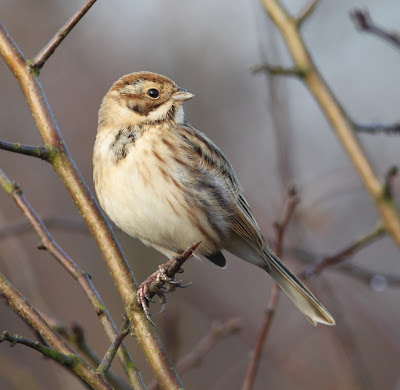Faced with where to go this morning, I realised I’d neglected Knott End of late, what with Christmas, then the poor weather followed by two weeks in Spain, so off I went for a look around the village hot spots.
The tide was on the way in, pushing a small selection of waders to the shore: 250 Curlew, 145 Oystercatcher, 60+ Redshank, 8 Turnstone, 2 Bar-tailed Godwit and 4 Dunlin. Shelduck were scattered across the sands and I counted 40+, although not a single Eider duck again.
When I walked along the esplanade I found 15 Twite, 2 Pied Wagtail and 1 Rock Pipit below the sea wall, and on the shore near the village a good count of 40+ Common Gull (Mew Gull - Larus canus) all in one spot. Common Gulls are rather handsome beasts which us bird watchers tend to forget about or ignore.
It wasn’t snowing today although it is forecast for Sunday and the picture below was taken at Knott End a year or two ago with a layer of snow on the sea wall.
Common Gull
Twite
A visit to Fluke Hall and a perusal of the usual stubble field close to the road gave counts of 18 Pied Wagtails, 18 Blackbirds, 8 Goldfinch, 2 Song Thrush, 1 Mistle Thrush, 1 Redwing, 40 Oystercatcher, 40 Lapwing, 22 Redshank and 15 Curlew.
The fields at Damside held 85 Golden Plover, 300 Lapwing, 40+ Redshank, 60 Curlew and a single Dunlin.
The Rawcliffe feeding station beckoned where it’s not just the top up which is important, it’s also weighing up whether a ringing session might be worthwhile soon if there are a decent number of birds about. I travelled over the Pilling Moss road where at my usual viewpoint there was a glimpse of a Hen Harrier, a frustrating view of a fast flying bird which even as I raised the camera was hundreds of yards away. I also had the camera set to over expose from a previous shot. It’s an excuse for a record shot, the bird looking away too.
Hen Harrier
The jury is still out on a ringing session for tomorrow, with 50+ Chaffinch, 2 Brambling, 15 Goldfinch and 10 Reed Buntings there or thereabouts the site but none of the birds exactly piling into the mixed seed left for them. There’s been a few returning north Fieldfares about this week, with another 20 or so today, mixed in with a small flock of Starlings in the hawthorn tops.
Reed Bunting
A look around the wider area found 4 pairs of Buzzards circling in the afternoon sun, 14 Stock Dove and 300+ Woodpigeon on the stubble, and a remarkable and noisy flock of about 1500 Jackdaws exploiting the last of a nearby maize field.
With rain and even snow forecast for the next three days there could be a lull in activities for Another Bird Blog, but please log in soon to find out. In the meantime log into Nature Footsteps http://nfmemes.blogspot.co.uk/ and Anni's blog for more winged creatures.

































































.jpg)












